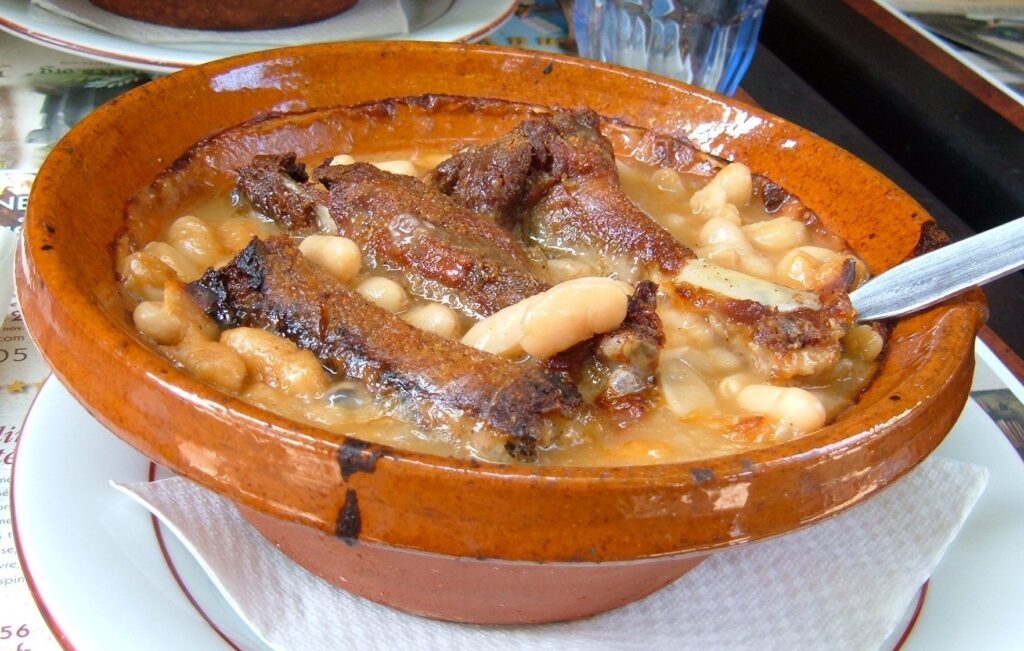Cassoulet de Castelnaudary
Cassoulet is not just a recipe whose origins are disputed, it’s also part of the heritage of the Cathar region of southwestern France.

Photo credits: BrokenSphere [CC BY-SA 3.0 (https://creativecommons.org/licenses/by-sa/3.0)]
In response to the many questions you’ve asked us when visiting your campsite near Carcassonne and Castelnaudary, we’ve decided to devote an article to it, and above all, to give you the real recipe for Castelnaudary Cassoulet.
The origin of the Cassoulet recipe
Its origins date back tomedieval times, around the 14th century. The recipe’s creator is said to be Guillaume Tirel, known as“Taillevent“, cook to kings for over 60 years. The first mention of this dish appears in his cookery book “Le Viandier”, which refers to a mutton and pork stew with broad beans. Some historians theorize that he was inspired by a recipe borrowed from the Arabs, which emphasized spices and herbs. Sheep stew with white beans is one of the recipes in the Baghdad Culinary Treatise. Taillevent would have taken this recipe and adapted it. Beans were later replaced by ingot beans, imported from South America by Christopher Columbus in 1530.
The story
Legend has it that the inhabitants of Castelnaudary, threatened by famine during the English siege of the town, pooled everything they had to feed the town’s soldiers. Bacon, pork, beans, sausages and meat were all simmered in a large bowl.
The soldiers, full of energy, drove the English out of the Lauragais and to the English Channel!
Where does the name Cassoulet come from?
Cassoulet gave its name to the dish in the 18th century. Its name comes from the“cassole“, a terracotta vessel glazed on the inside to make it non-porous, produced in the village of Issel, north of Castelnaudary. The mythical local dish simply took its name from the vessel in which it was cooked.
Cassoulet recipe for 4 people
“Ingredients
- 350-400 g lingot beans (preferably from the Lauragais region)
- 2 duck or goose confit legs, halved.
- 4 – 80g pieces of pure pork “Toulouse” sausage.
- 4 – 50g pieces of pork from the shank, shoulder or belly
- 250 g pork rind, half of which will be used after cooking to assemble the cassoulet.
- A little salted bacon
- 1 poultry carcass or a few pork bones onions and carrots
The Recipe
The day before: Soak the dried beans overnight in cold water.
The next day:
- Pour off the water, place the beans in a saucepan with three liters of cold water and boil for 5 minutes. Turn off the heat, drain the water and set the beans aside.
- Prepare the stock with another 3 liters of water (non calcareous and from Castelnaudary if possible), the rind cut into wide strips, a poultry carcass if available or a few pork bones and, to taste, a few onions and carrots. Season generously with salt and pepper. Cook for an hour, then strain the stock and remove the rind.
- Place the beans in the filtered stock and cook until they are soft but still whole. This takes about an hour of boiling.
While beans are cooking, Meat preparation :
- Degrease the pieces of confit in a large frying pan over low heat, then set aside.
- Brown the Toulouse sausages in the remaining fat, then set aside.
- Brown the pork pieces until golden brown and set aside with the other meats.
- Drain the beans and keep the stock warm. Add to the beans a few cloves of garlic and double the weight of salted bacon, crushed together.
Cassoulet assembly:
To do this, use the hollow terracotta dish known as “cassolo” (now called “la cassole”) which gave its name to cassoulet, or alternatively a fairly hollow ovenproof terracotta dish.
- Line the bottom of the cassole with pieces of rind
- add about a third of the beans
- arrange the meats and pour the rest of the beans on top
- Arrange the sausages by pressing them into the beans, leaving the top of the sausages visible.
- Complete the cassole by pouring in the hot broth, which should just cover the beans.
- Grind pepper on the surface and add a tablespoon of the duck fat used to brown the meats.
Cooking :
- Place in the oven at 150°/160° (Thermostat 5 or 6) and bake for two to three hours.
- During baking, a golden-brown crust will form on the top of the cassole, which needs to be pressed down several times (the ancients used to say 7 times).
- When the top of the beans begins to dry, add a few spoonfuls of stock.
If you prepare this cassoulet the day before, it should be reheated in the oven at 150° for an hour and a half before serving. Don’t forget to add a little broth or, failing that, a few spoonfuls of water.”
source:recipe and historical sources taken from the website of the Grande Confrérie du Cassoulet de Castelnaudary, a comprehensive site on the history of cassoulet.
The wine that goes with Cassoulet
Choose AOC Malepère, wines from the Malepère massif. Produced on the outskirts of Carcassonne, its fruity bouquet is a perfect match for this flavorful dish.
Did you know that there is a Cassoulet road? Discover it here
Enjoy the tasting and see you soon at your campsite near Carcassonne.
tags: cassoulet recipe, camping near carcassonne, camping aude, castelnaudary




















